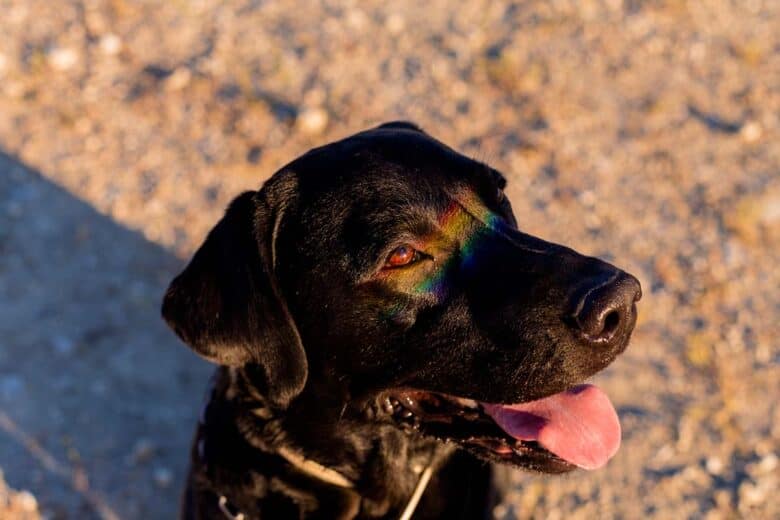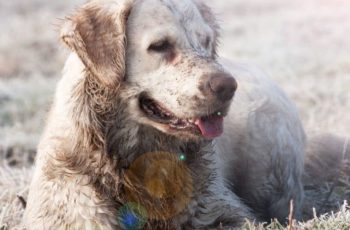This post may contain affiliate links. We may earn money or products from the companies mentioned in this post.
They say the window to a dog’s gentle soul is through his eyes. But what if those eyes are red and swollen?
It can be disconcerting to look down and see that your dog’s usually bright eyes are suddenly red.
What could be causing your dog’s red eyes? Is it serious?

In this article, we’ll discuss what causes a dog’s eyes to become red, what solutions there are, and tips for keeping your dog’s eyes healthy.
Contents & Quick Navigation
How A Dog’s Eyes Should Look
Though they work a little differently, a dog’s eyes are just as important as your own. The eyes are constantly adjusting to different lighting, focusing on objects, and taking in visuals that are then sent to the brain for processing.
Think of all the times your dog spots a squirrel from halfway down the block or notices something in the dark. These are common examples of just how sharp your dog’s eyesight is.
Although dogs don’t see the same range of colors we do, their superior ability to track light and movement is because of additional rods in their corneas.
Dogs have three eyelids, with the third known as the nictitating membrane. The third eyelid can be found in the inside corner of the eye and the purpose is to protect your dog’s eyes and lubricate it as it spreads the tear film. If there is inflammation in this third eyelid, it will be swollen.
Some dog breeds are more prone to eye issues. Breeds with long hair around their face – such as the poodle, sheepdog, and Maltese – are more likely to get dust, hair, and other external irritants into their eyes.
Older dogs are more prone to high blood pressure and other illnesses that could affect their eye health. Red eyes are also more common in dogs with brachycephalics where they have “smooshed in” faces. Breeds with brachycephalic faces include bulldogs and pugs.
A healthy dog’s eyes will be clean, tear-free, discharge-free, and crust-free. Additionally, the pupils should be the same size. Something may be wrong if your dog’s eyes’ pupils are not the same size, if you can see the third eyelid, and if there is cloudiness.
Why Dogs’ Eyes Get Red
Dogs’ eyes get red, weepy, and/or bloodshot for a number of reasons, some of which are serious and some of which are totally harmless.
External irritants might make a dog’s eyes feel very uncomfortable, while certain illnesses can also weaken or damage parts of the eye.
Below, we look at the most common reasons for a dog’s eyes to become red, along with some treatments you can try.
Eye Trauma
“Eye trauma” describes the presence of a foreign object in the eye. Just like our eyes, dirt, dust, grass, hair, and other small annoyances can make their way into a dog’s eyes and irritate them.
Symptoms Of Eye Trauma
- Eye redness
- Tears or watery discharge
- Itchiness
What To Do
First, wait an hour or two to see if the eyes brighten up on their own. Chances are, your dog will take care of whatever is in his eye.
If your dog will tolerate it, look in his eye to see if there is an irritant. Use a moist cloth to gently wipe the eye, then wait another hour.
Put in a call to your veterinarian for further instruction and assistance if your dog’s eyes don’t clear up after you’ve wiped it out
Allergies
Your dog’s eyes could be red because of allergies to food or something in their environment. Seasonal allergies and intolerance to pollen are just as common in dogs as in humans. Other common dog allergens include proteins, different kinds of wheat, certain human foods, and some insects.
Symptoms Of Allergies
If your dog is experiencing an allergic reaction, they may be showing any number of the following symptoms:
- Red eyes
- Tears and watery discharge
- Itchiness (itchy eyes and/or body)
- Licking and scratching
- Sneezing
- Red or inflamed skin
- Hair loss
What To Do
If you suspect your dog is having an allergic reaction, then place a call to your vet for further assistance.
Do not give your dog any kind of over-the-counter antihistamine without first consulting your vet. The right antihistamine will depend on what your dog is having an allergic reaction to, and the proper dose will be determined by your dog’s exact weight.
Discovering what it is your dog is allergic to can be a long and complicated process, but it’s worth working with your vet to ensure your dog’s health and comfort.
Pinkeye
Pinkeye, officially known as conjunctivitis, is a very common ailment for both pets and humans. Conjunctivitis occurs when the conjunctiva, or the thin membrane that covers the eyeball, is inflamed or infected.
There are two types of pinkeye: infectious and noninfectious. Noninfectious pinkeye can be caused by allergies, irritation, injury, or an illness like distemper. Infectious pinkeye is caused by a virus or bacterial infection.
Symptoms Of Pinkeye
Your dog may have pinkeye if you are noticing some of these symptoms:
- Red, puffy eyes
- Itchiness
- Watery or goop-like discharge
- Squinting or eyelids sticking together
- Swollen eyelid lining
What To Do
All pinkeye should be checked out by a veterinarian, though the treatment will depend on whether or not your dog’s pinkeye is infectious. In any case, your vet will likely prescribe an anti-inflammatory eye drop. An antibacterial or antifungal medicine will be prescribed in the case of infectious conjunctivitis.
And because you are surely wondering: yes, a dog can infect a human with conjunctivitis, and a human can infect a dog. Fortunately, this occurrence is pretty rare. It’s much more common for a human to infect a human and a dog to infect a dog.
Glaucoma
Glaucoma is a build-up of fluid that puts pressure on the eye. It is characterized by redness and visible swelling. If left untreated, it can cause blindness.
Symptoms Of Glaucoma
If your dog is experiencing any of these symptoms, then glaucoma could be the culprit:
- Redness of the eye
- Pain or discomfort
- Swollen eyes
- Receding eyeballs
- A cloudy appearance of the eye
- Dilated and unresponsive pupils
- Poor vision
What To Do
Glaucoma is a serious condition that is painful for your dog. It requires immediate vet care. If you suspect your dog has glaucoma, then it’s important to have your dog seen by a vet as soon as possible.
If caught early, glaucoma can be stopped with a topical medicine and/or a simple laser surgery.
A more severe case of glaucoma will require surgery to release fluid and relieve pressure on the eye.
If your dog’s glaucoma has become too advanced, then your vet may need to remove the eye via a surgical procedure.
Dry Eye Syndrome
Dry eye syndrome – or keratoconjunctivitis sicca, as it’s officially known – occurs when your dog’s tear glands aren’t producing enough tears. This causes the eye tissue to dry out and become very uncomfortable.
Symptoms Of Dry Eye Syndrome
If you think your dog is suffering dry eye syndrome, there are the symptoms to look out for:
- Redness in the eyes
- Thick discharge
- Itchy, painful eyes
What To Do
Dry eye syndrome can be caused by trauma or an underlying illness, so it’s important to have your pet checked out by their veterinarian.
The vet will conduct a couple of tests to check the level of moisture in your dog’s eyes and to look for ulcers on her corneas. Your veterinarian will likely prescribe drops to keep your dog’s eyeballs comfortably moist.
Sometimes dry eye syndrome clears up on its own. Other times, it is a chronic issue that requires lifelong treatment that includes daily eye cleaning.
Uveitis
Uveitis is a painful inflammation of specific parts of your dog’s eyeballs. In some cases, a specific cause for uveitis is not found. In other cases, uveitis can come about as a result of trauma, infection, parasites, or an underlying autoimmune or inflammatory disease. It can appear in one eye or both.
Symptoms Of Uveitis
If you notice your dog’s eyes are red and suspect they may be in pain, then uveitis could be to blame. The most common symptoms of uveitis in dogs include:
- Extreme eye redness
- Squinting or being unable to open the eye
- Avoiding bright lights
- A cloudy appearance in the eyes
- Bleeding or tearing in the eye (best identified by a veterinarian)
What To Do
When left untreated, this serious condition can lead to permanent blindness. To alleviate your dog’s pain and avoid permanent vision loss, make sure your dog sees the vet as soon as possible. If the vet determines your dog’s uveitis is caused by something related to their immune system, then lifelong care and medication are required.
If your veterinarian finds that your dog’s uveitis is caused by injury, infection, or a parasite, then you will likely be prescribed a steroid-based medication. Expect 2-5 weeks of treatment for your dog’s eyes to fully heal. In some cases, the healing process will take several months to fully resolve.
Corneal Ulcers
Corneal ulcers occur in dogs’ eyes just as they do in ours. These ulcers occur when the cornea suffers an abrasion, and fluid begins to accumulate in the eye’s stroma, or the membrane that covers the front of the eyeball. This build up of fluid causes the eye to appear gray and cloudy.
Most commonly, a corneal ulcer is caused by a scratch, like from an accidental scratch with a brush, or trauma.
Symptoms Of Corneal Ulcers
Corneal ulcer symptoms include:
- Extreme redness in the eye
- Pain and discomfort
- Squinting, excessive blinking, or holding the eye completely closed
- Discharge
- Swelling in the eye
- Gray, cloudy appearance
What To Do
Corneal ulcers are another cause of redness in dogs’ eyes that requires a trip to the veterinarian.
Once diagnosed, your dog will probably be prescribed an antibiotic ointment or eye drops that you’ll need to apply two to four times per day. The purpose of the antibiotic is mostly to keep the dog’s eyes comfortable and lubricated while they heal.
Underlying Issues
In some cases, your dog’s red eyes are caused by an illness or underlying issue that will need to be diagnosed by a vet. Underlying issues that cause eye redness include diabetes, hyperthyroidism, and even some cancers. An illness such as distemper is another possibility.
When To Ask A Vet About Red Eyes
If you notice that your dog’s eyes are red, then you are probably feeling a little worried. But before you panic, there are a couple of things you can do before placing a call to your vet.
First, wait a couple of hours to see if your dog’s eyes clear up on their own. You can also check around the eyes and eyelids to see if you can spot any dirt specks or loose hair, but only do this if your dog will tolerate it. Should you spot something, you can wipe it away with a lukewarm wet cloth.
If your dog’s eyes don’t clear up within two hours, then a call to your vet’s office is recommended. Eye issues can progress very quickly, but your vet will be able to give you some instruction or let you know if a visit is required.
Contact your veterinarian if you notice:
- Something new or strange in, on, or around your dog’s eyes
- Your dog is scratching at their eyes or rubbing their face
- Unusual discharge
- Extensive squinting or your dog refuses to open their eyes
What To Expect At The Veterinarian
At your dog’s veterinary appointment, the vet will perform a couple of tests to find out the severity of your dog’s eye redness.
The vet will likely start with an ophthalmologic exam, during which they’ll use an ophthalmoscope to track your dog’s vision and look at the internal structures of your dog’s eyes.
A Schirmer test is conducted to make sure the eye is producing enough tears to stay lubricated. The vet will place a filter paper inside the lower lid of the eye. A few minutes later, the vet will remove it to check its moisture content.
Your vet may also use a tonometer to test the internal pressure of your dog’s eyes.
If your vet suspects a corneal injury or corneal ulcers, then they might use a fluorescein stain test. For this test, a dye is dropped into the eye, which allows the vet to see any injuries that would otherwise be too small to notice.
The vet may also find it necessary to do a blood test to check for any underlying illnesses that could cause eye issues.
Tips For Keeping Your Dog’s Eyes Healthy
The health of your dog’s eyes is an important part of their overall well-being. It’s important to keep your dog’s eyes clean and clear of anything that could cause inflammation, infection, or injury. To maintain your dog’s ocular health:
- Keep longer hair clean and trimmed around the eyes.
- Promptly clean any crust or gunk from your dog’s eyes using a damp cloth or tissue. Wipe from the inside corner of the eye outwards, and try not to touch the eyeball itself.
- If your dog is rubbing or scratching at their eyes, = this is a sure sign they are bothering her. Keep a close eye on your dog (no pun intended), so you can help notice any problems as soon as possible.
- Avoid letting your dog hang their head out of the car window. Sure, it’s adorable, but it’s also the leading cause of eye injury in dogs. For the cool canine that loves car rides, you can purchase a pair of doggles to protect their eyes from dangerous debris.
- Maintain your dog’s check-up schedule, so a vet is able to examine their eyes on a regular basis. Younger dogs should see the vet once per year, while an older pet should be checked out twice each year.
A Final Word
A canine’s eyes are complicated organs that help it to focus on objects, see in all kinds of lighting, and of course, gaze at you lovingly.
If you notice any changes in the appearance of your dog’s eyes, or in their behavior, then it is worth looking into.
While most cases of red eyes in dogs are temporary and not very serious, there are some more emergent causes like glaucoma and uveitis that could cause permanent blindness.
If you notice your dog’s red eyes aren’t clearing up after a gentle wipe, then a trip to the vet is recommended.
Chances are your vet will be able to diagnose and treat your pet’s red eyes in no time, and you and your dog can get back to gazing at each other lovingly.
Save To Pinterest

Top Picks For Our Dogs
- BEST PUPPY TOY
We Like: Snuggle Puppy w/ Heart Beat & Heat Pack – Perfect for new puppies. We get all of our Service Dog pups a Snuggle Puppy. - BEST CHEW TOY
We Like: KONG Extreme – Great toy for heavy chewers like our Labrador Retrievers. - BEST DOG TREATS
We Like: Wellness Soft Puppy Bites – One of our favorite treats for training our service dog puppies. - BEST FRESH DOG FOOD
We Like: The Farmer’s Dog – A couple months ago we started feeding Raven fresh dog food and she loves it! Get 50% off your first order of The Farmer’s Dog.
For a list of all the supplies we get for our new service dog puppies check out our New Puppy Checklist on the PuppyInTraining.com blog.
Why Are My Dog’s Eyes Red? Causes & Treatment Of Eye Redness In Dogs was last modified: July 7th, 2021 by


